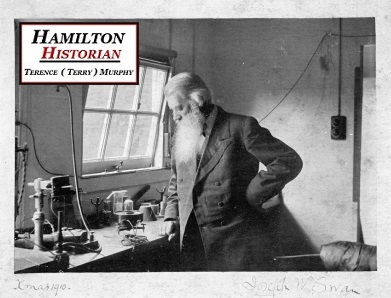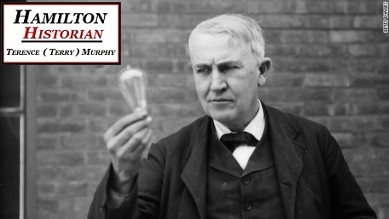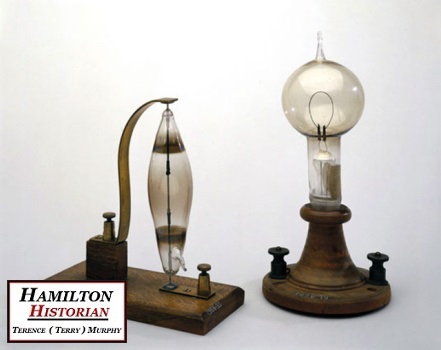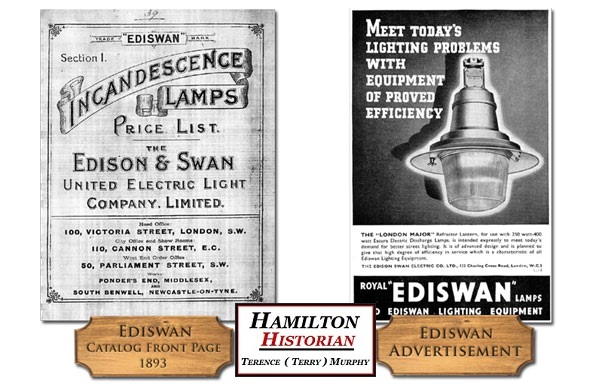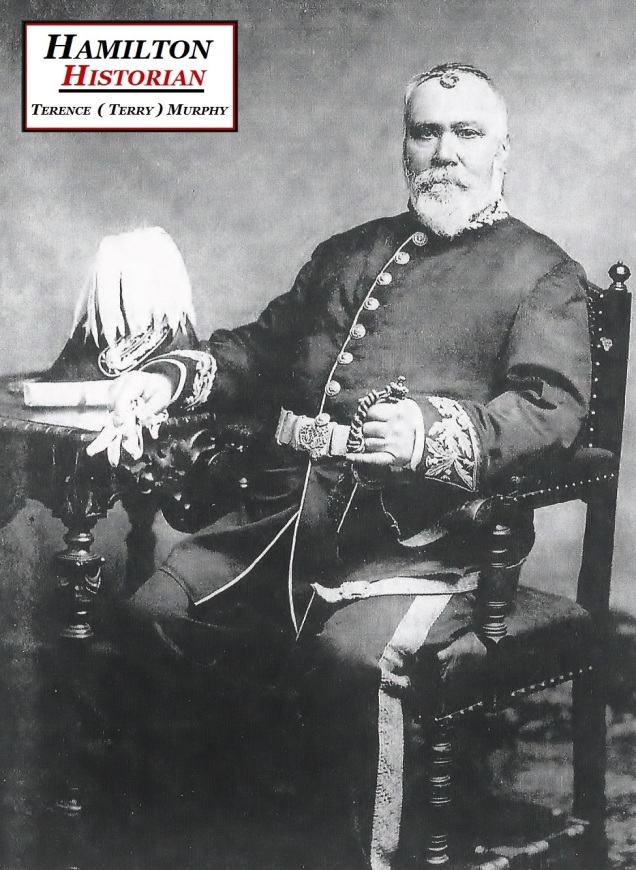
Jock Stein whilst playing at Celtic.
Jock Stein was born on October 5th 1922 at Burnbank which is near Hamilton West Train Station in the town of Hamilton , Lanarkshire. He left school aged 15 and started work as a miner in 1937. He joined the Blantyre Victoria Junior Football Club in 1938. In 1942 he became a Semi-Professional Player with Albion Rovers and he was still working as a miner at the time.
He later became Full Professional in 1950 with Welsh Team AFC Llanelli. Earning the princely some of £12 per week. He was bought by Celtic Football Club in 1951 for £1,200. and the following year he was made Club Captain. He was with Celtic up until 1956 and played 148 games but only scored 2 goals. He retired from playing due to ankle injuries. Whilst he was Club Captain at Celtic they won the Coronation Cup in 1953, the League Championship and Scottish Cup Double in 1954.
He later became Celtic’s Youth Team Coach. During 1960 he took on the role of Manager at Dunfermline. In 1961 they won the Scottish Cup. In 1964 Stein returned to Celtic FC and became the team’s first non-catholic Manager. They won the Scottish Cup 6 weeks after his arrival. The following season Celtic were Scottish League Champions (the first time in 11 years!). They also reached the semi-finals of the European Cup -Winners-Cup!
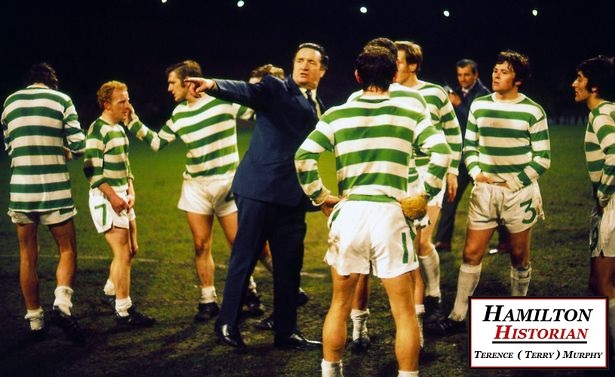
Jock Stein with the Celtic Team.
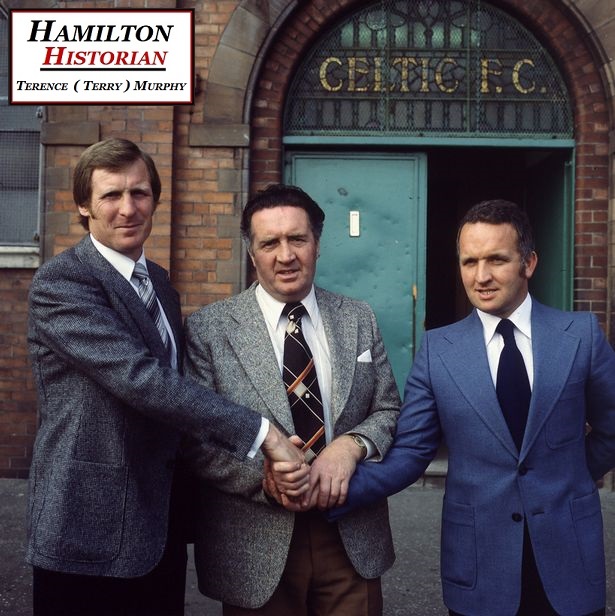
Billy McNeil, Jock Stein and John Clark.
The following season Celtic reached the Scottish Domestic Treble of the Scottish League Cup, the League Championship and the Scottish Cup. And of course in 1967 Celtic Football Club won the European Cup after beating Inter Milan in the finals! Big Jock Stein led Celtic to 9 successive League Championships. He was awarded the CBE in 1970. He was seriously injured in a car accident in 1975. In 1978 he left Celtic and was Manager at Leeds for a brief period of time, until he became Manager of Scotland’s National Team.
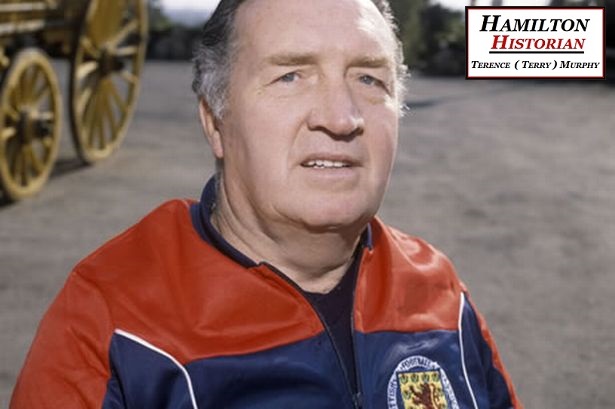
Jock Stein Manager at Scotland.
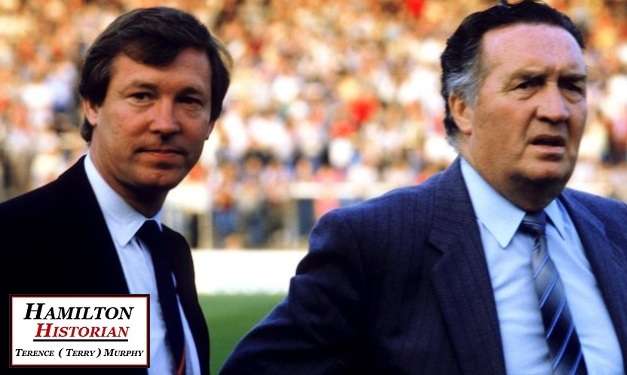
Alex Ferguson and Jock Stein.
Stein led Scotland in the 1982 World Cup but they lost on goal difference to the Soviet Union during the group stages. Stein introduced a young Alex Ferguson as his Assistant during qualifications for the 1986 World Cup. Ferguson at the time was manager at Aberdeen. On the 10th September 1985 Big Jock Stein died after suffering a heart attack at the end of a 1-1 Draw with Wales at Ninian Park in Cardiff. He was only 62 years old!
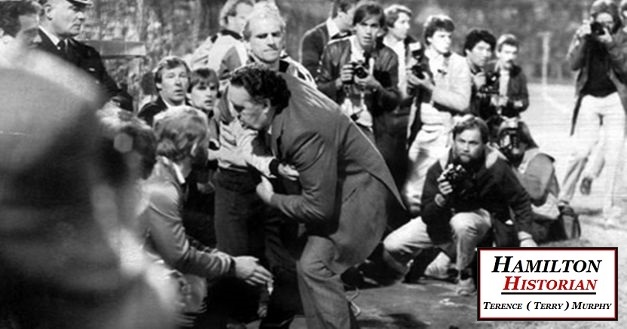
The fateful moment when Jock Stein suffered his heart attack caught on camera!
Written by
Hamilton Historian
Terence (Terry) Murphy.
Ref. Jock Stein Wikipedia and various football magazines.

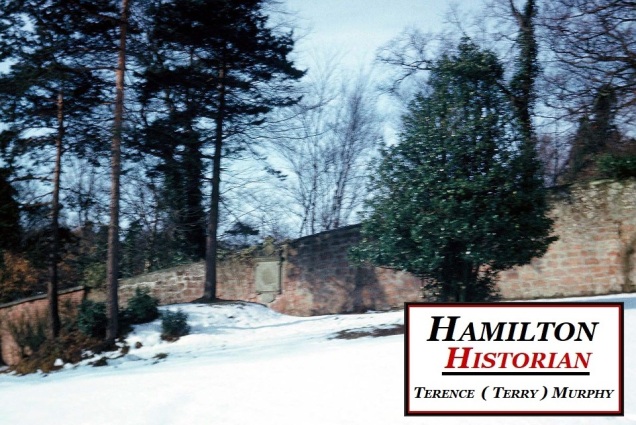 Original Plaque/Memorial which was built into the wall at Earnock Gardens.
Original Plaque/Memorial which was built into the wall at Earnock Gardens.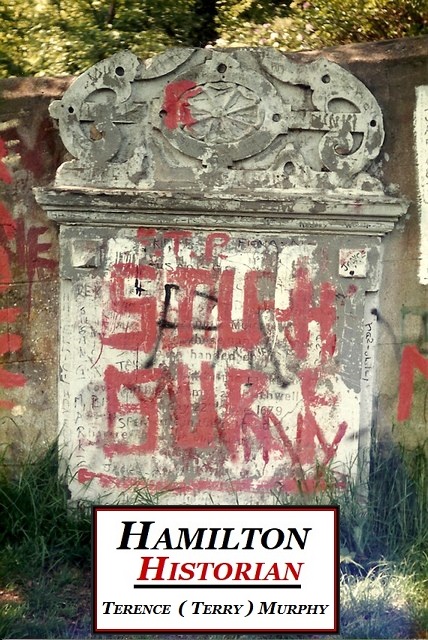 The original stone memorial/plaque vandalized c. 1988.
The original stone memorial/plaque vandalized c. 1988. The original stone memorial/plaque at Hamilton’s Old Parish Churchyard.
The original stone memorial/plaque at Hamilton’s Old Parish Churchyard.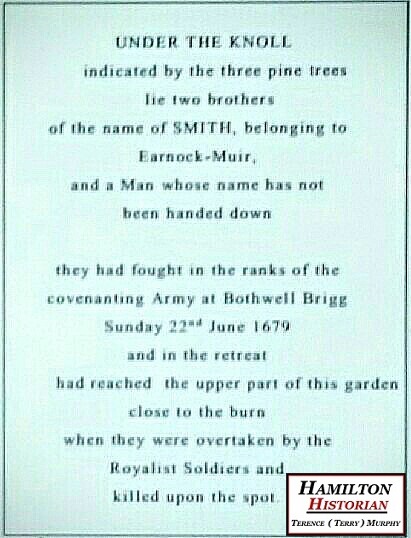 Original memorial/plaque inscription.
Original memorial/plaque inscription.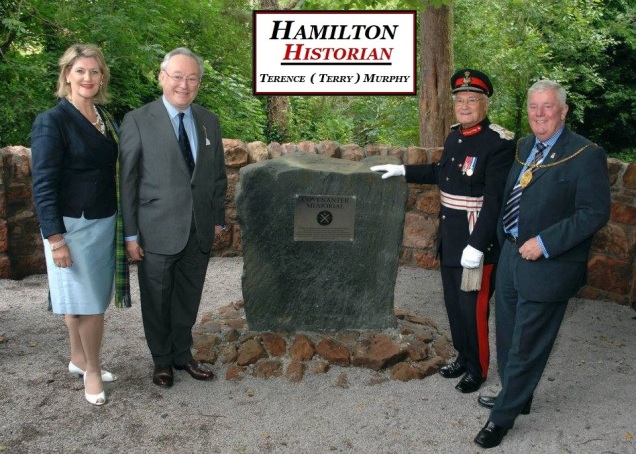 Lady Patricia Watson, The Late Sir Simon Watson Bt, Lord Lieutenant of Lanarkshire and Provost at memorial unveiling c.2008.
Lady Patricia Watson, The Late Sir Simon Watson Bt, Lord Lieutenant of Lanarkshire and Provost at memorial unveiling c.2008.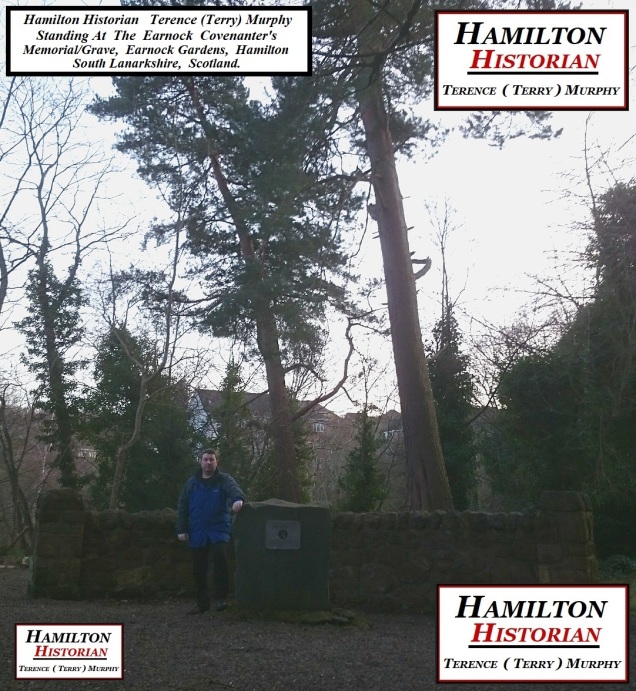 Hamilton Historian Terence (Terry) Murphy At The Earnock Covenanter’s Memorial c.2019.
Hamilton Historian Terence (Terry) Murphy At The Earnock Covenanter’s Memorial c.2019.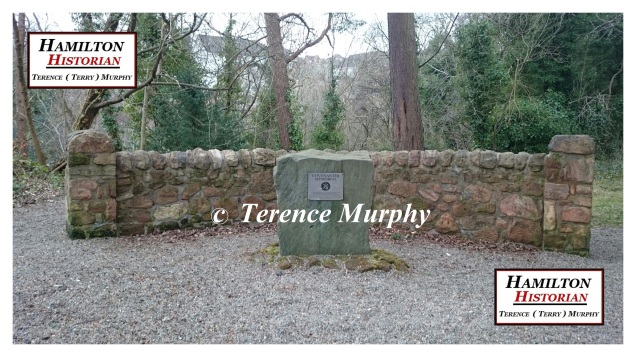 Earnock Covenanter’s Memorial c.2016.
Earnock Covenanter’s Memorial c.2016.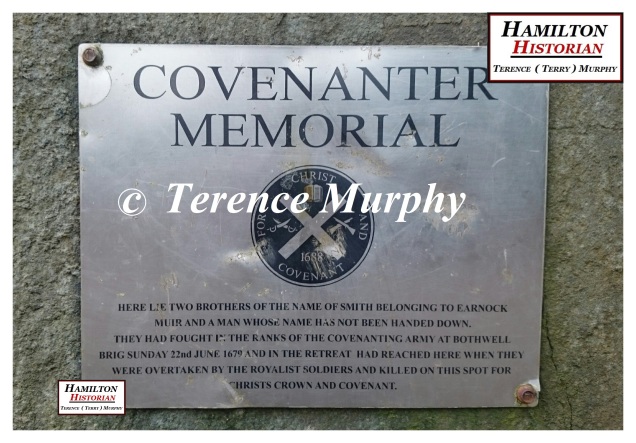 Plaque Inscription details.
Plaque Inscription details.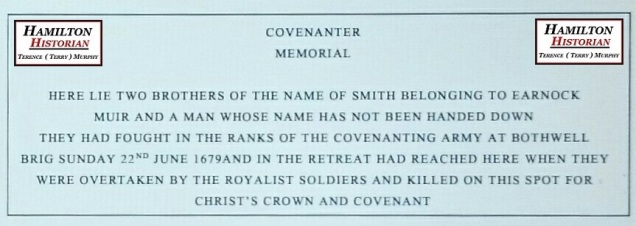 Plaque inscription details.
Plaque inscription details. View of the memorial with full view of Scots Pine trees from the front.
View of the memorial with full view of Scots Pine trees from the front. In this view from behind the memorial you can see the mound/knoll which marks the grave where the Covenanter’s are buried. In recent years a Scots Pine sapling was planted to replace another one of the trees that had blown over.
In this view from behind the memorial you can see the mound/knoll which marks the grave where the Covenanter’s are buried. In recent years a Scots Pine sapling was planted to replace another one of the trees that had blown over. Location of Unmarked Covenanter’s Grave at Laighstonehall, Hamilton, Lanarkshire. During the 1980’s the cement cap was embeded with pebbles. The area where the grave is located is circled in red in the photo c.2016.
Location of Unmarked Covenanter’s Grave at Laighstonehall, Hamilton, Lanarkshire. During the 1980’s the cement cap was embeded with pebbles. The area where the grave is located is circled in red in the photo c.2016.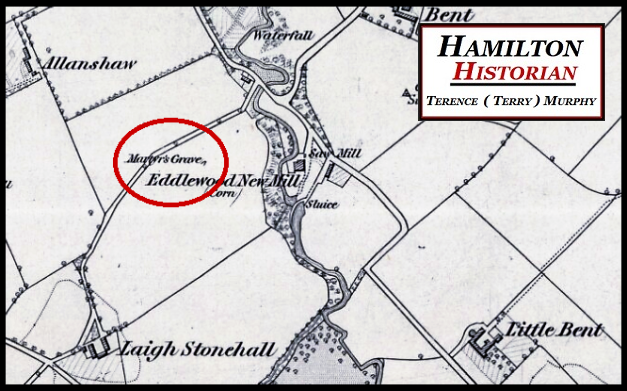 Ordnance Survey Map Clipping Showing Location Of Martyr’s Grave Location Circled In Red. Map Survey c.1858, publication c.1864.
Ordnance Survey Map Clipping Showing Location Of Martyr’s Grave Location Circled In Red. Map Survey c.1858, publication c.1864.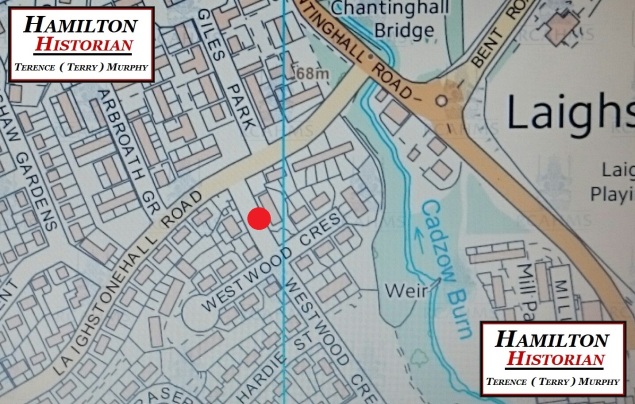 Present day Street map clipping showing location of grave marked by red dot.
Present day Street map clipping showing location of grave marked by red dot.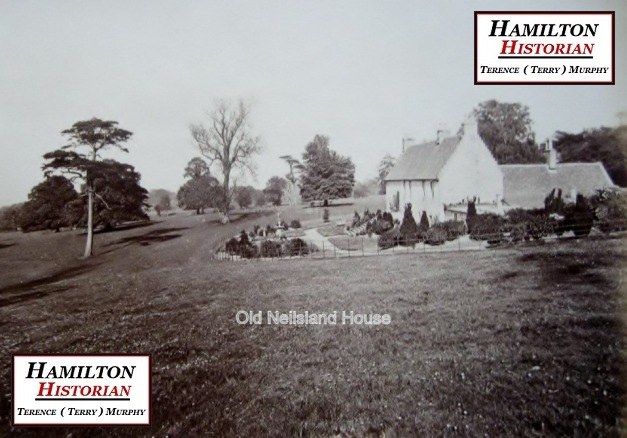 Old Neilsland House c.1877 (This is the current day location of the Woodhead Bar).
Old Neilsland House c.1877 (This is the current day location of the Woodhead Bar). Hamilton Historian Terence (Terry) Murphy Standing Beside The Original “Neilsland Park”, “Nature Trail” Sign At The Woodhead Green Entrance To The Former Neilsland (Midstonehall) Estate.
Hamilton Historian Terence (Terry) Murphy Standing Beside The Original “Neilsland Park”, “Nature Trail” Sign At The Woodhead Green Entrance To The Former Neilsland (Midstonehall) Estate.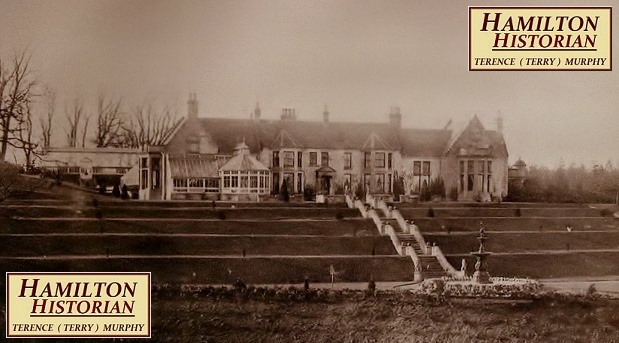 Neilsland Mansion House (Mid Stonehall) c.1873.
Neilsland Mansion House (Mid Stonehall) c.1873.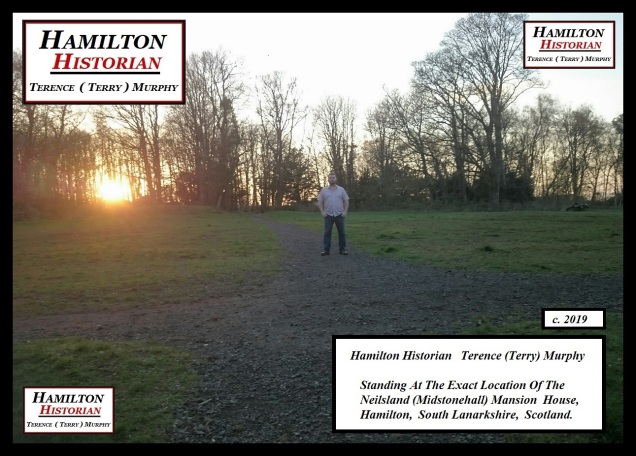 Hamilton Historian Terence (Terry) Murphy Standing At The Exact Location Of The Neilsland Mansion House c.2019.
Hamilton Historian Terence (Terry) Murphy Standing At The Exact Location Of The Neilsland Mansion House c.2019. Hamilton Historian Terence (Terry) Murphy Standing At The Foot Of The Original Stone Staircase Between The Neilsland Mansion House & Decorative Fountain Below c.2019.
Hamilton Historian Terence (Terry) Murphy Standing At The Foot Of The Original Stone Staircase Between The Neilsland Mansion House & Decorative Fountain Below c.2019.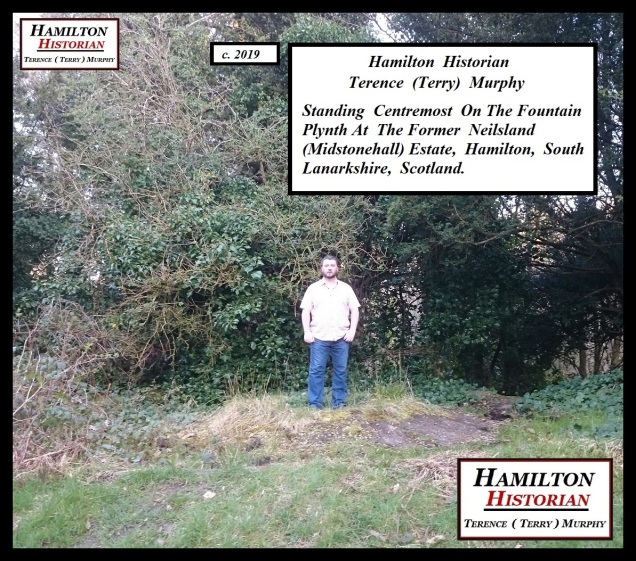 Hamilton Historian Terence (Terry) Murphy Standing Centremost On The Fountain Plynth In The Neilsland (Midstonehall) Estate c.2019.
Hamilton Historian Terence (Terry) Murphy Standing Centremost On The Fountain Plynth In The Neilsland (Midstonehall) Estate c.2019. Hamilton Historian Terence (Terry) Murphy Showing Stone Staircase Remains c.2019.
Hamilton Historian Terence (Terry) Murphy Showing Stone Staircase Remains c.2019.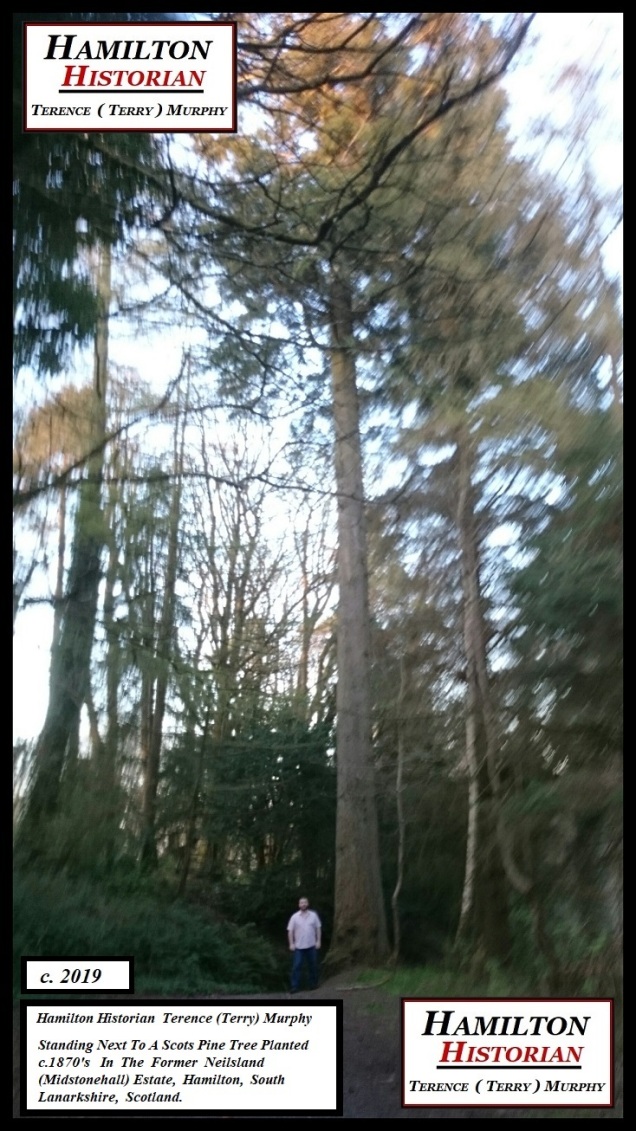 HAMILTON HISTORIAN TERENCE (TERRY) MURPHY BESIDE A SCOT’S PINE PLANTED c. 1870’S IN THE NEILSLAND (MIDSTONEHALL) ESTATE C.2019.
HAMILTON HISTORIAN TERENCE (TERRY) MURPHY BESIDE A SCOT’S PINE PLANTED c. 1870’S IN THE NEILSLAND (MIDSTONEHALL) ESTATE C.2019. Tor Lake (Tally Hoe) c.1877.
Tor Lake (Tally Hoe) c.1877. Rockery with Small Waterfall at Neilsland c.1877.
Rockery with Small Waterfall at Neilsland c.1877.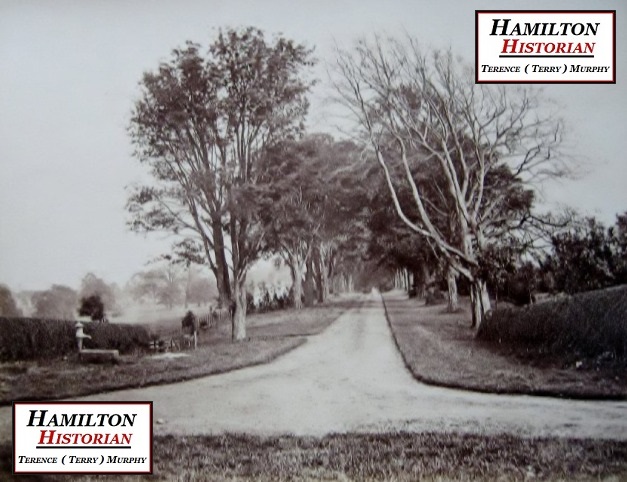 A tree lined Avenue between Old Neilsland and Woodhead was created in 1873. This photo c. 1877.
A tree lined Avenue between Old Neilsland and Woodhead was created in 1873. This photo c. 1877.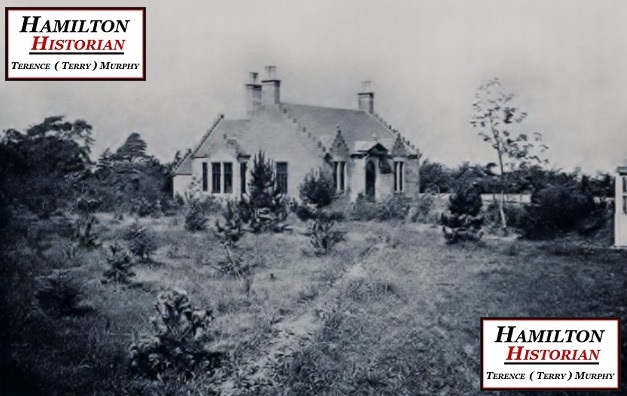 Gamekeeper’s House at Woodhead c.1877.
Gamekeeper’s House at Woodhead c.1877.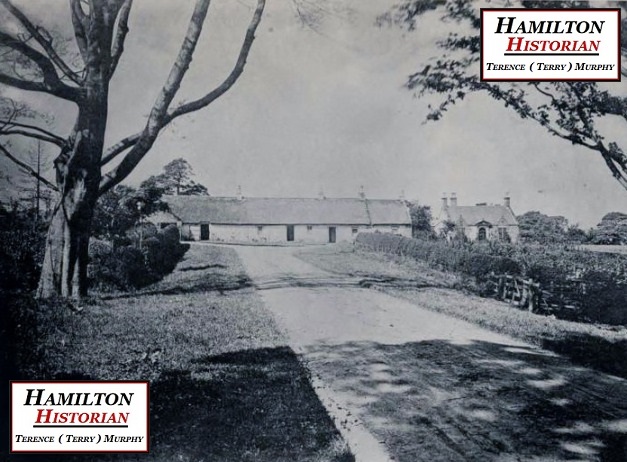 Cottages & Gamekeeper’s House at end of Avenue at Woodhead. c.1877.
Cottages & Gamekeeper’s House at end of Avenue at Woodhead. c.1877.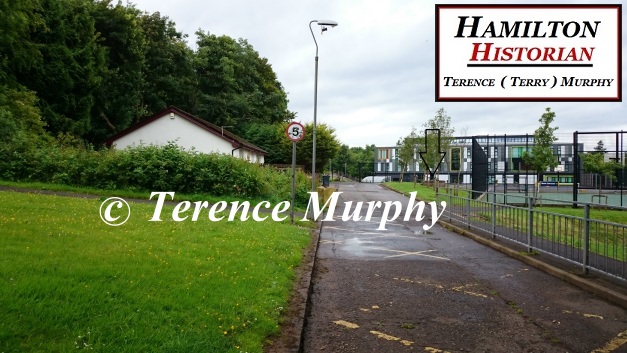 The former location of the Cottages and Gamekeeper’s House at the end of the Avenue at Woodhead. The arrow marks the location of the well which is also visible in the 1877 photo. Woodhead Primary is in the background c.2016.
The former location of the Cottages and Gamekeeper’s House at the end of the Avenue at Woodhead. The arrow marks the location of the well which is also visible in the 1877 photo. Woodhead Primary is in the background c.2016.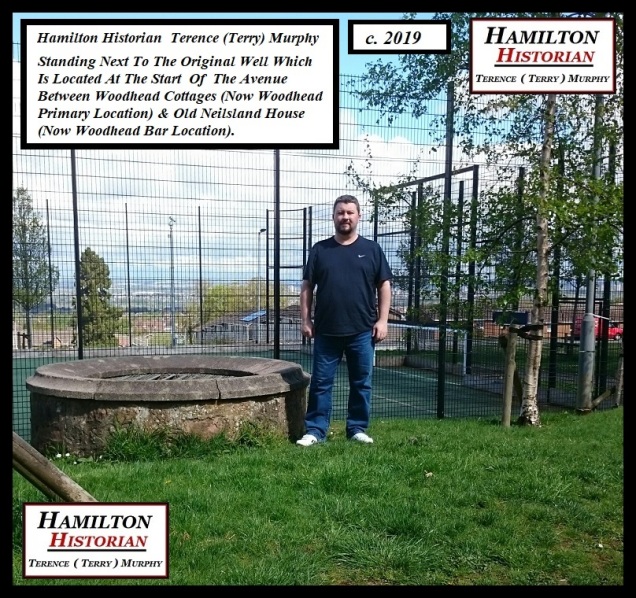 Hamilton Historian Terence (Terry) Murphy Standing Next To A Well At The Original Avenue Between Woodhead & Old Neilsland c.2019.
Hamilton Historian Terence (Terry) Murphy Standing Next To A Well At The Original Avenue Between Woodhead & Old Neilsland c.2019. c.1910 map clipping showing Avenue and other Key Features of the estate.
c.1910 map clipping showing Avenue and other Key Features of the estate.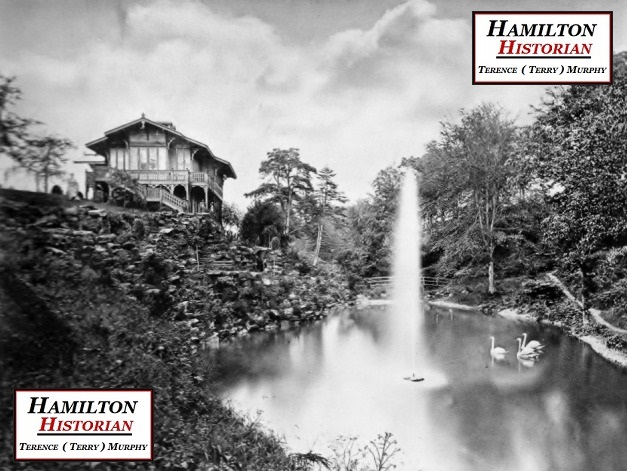 Swiss Cottage, Neilsland c.1877. Lord Byron Statue Is Visible Just Left of the Cottage.
Swiss Cottage, Neilsland c.1877. Lord Byron Statue Is Visible Just Left of the Cottage.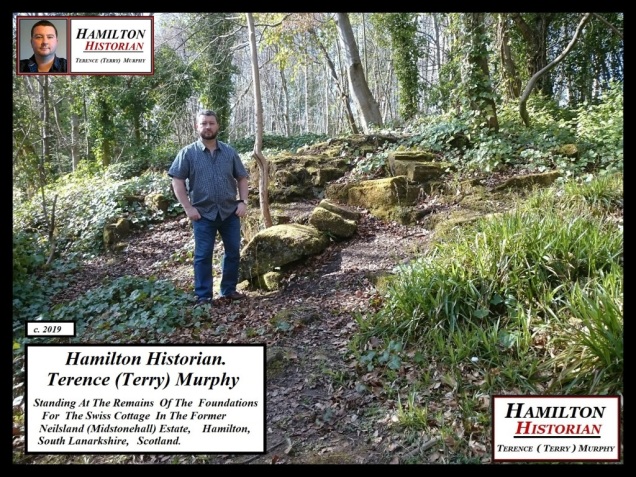 HAMILTON HISTORIAN TERENCE (TERRY) MURPHY AT THE FOUNDATION REMAINS OF THE SWISS COTTAGE IN THE FORMER NEILSLAND (MIDSTONEHALL) ESTATE C.2019.
HAMILTON HISTORIAN TERENCE (TERRY) MURPHY AT THE FOUNDATION REMAINS OF THE SWISS COTTAGE IN THE FORMER NEILSLAND (MIDSTONEHALL) ESTATE C.2019.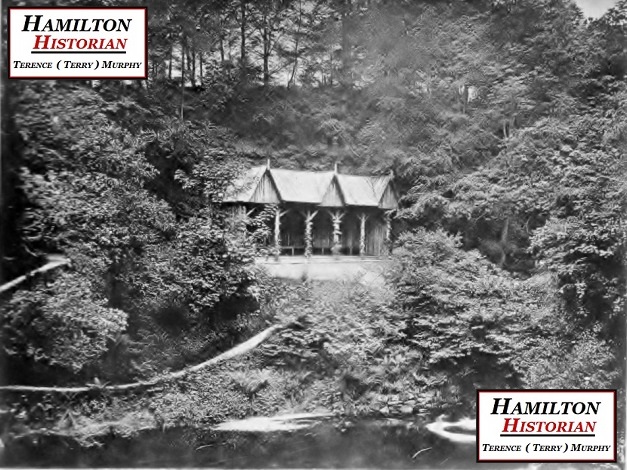 The Summer-House was constructed across from the Swiss Cottage at a lower level on the other side of the pond. This photo c.1877.
The Summer-House was constructed across from the Swiss Cottage at a lower level on the other side of the pond. This photo c.1877. Burnhouse (Whisky Well Cottage) c.1877.
Burnhouse (Whisky Well Cottage) c.1877.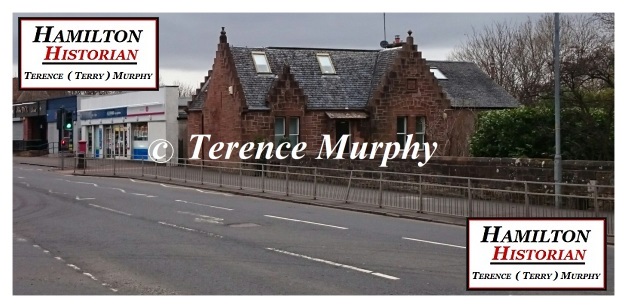 Burnhouse (Whisky Well Cottage) c.2016. You can see the extension on the right of the building which was added during the 1990’s. Located at 51 Neilsland Rd, Hamilton, South Lanarkshire ML3 8HQ. It is a Grade C British Listed Building.
Burnhouse (Whisky Well Cottage) c.2016. You can see the extension on the right of the building which was added during the 1990’s. Located at 51 Neilsland Rd, Hamilton, South Lanarkshire ML3 8HQ. It is a Grade C British Listed Building.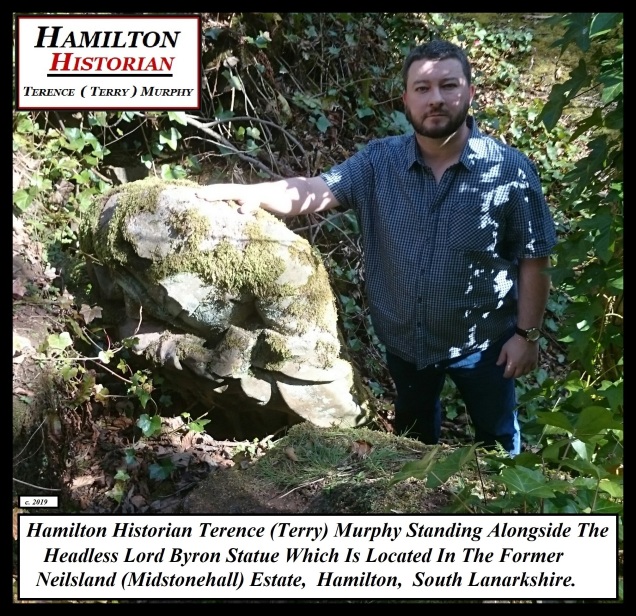 Hamilton Historian Terence (Terry) Murphy With The headless remains of Lord Byron located at the Rockery c.2019.
Hamilton Historian Terence (Terry) Murphy With The headless remains of Lord Byron located at the Rockery c.2019.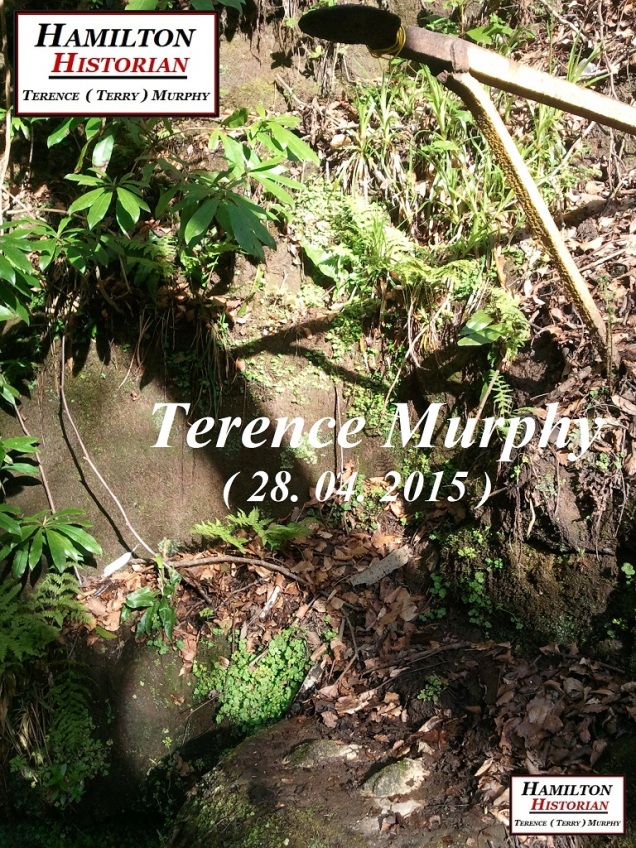
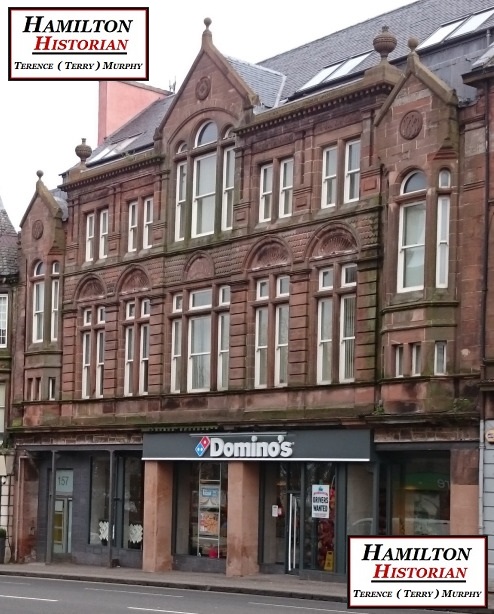 The Victoria Building/Hamilton Granada Theatre c.2016.
The Victoria Building/Hamilton Granada Theatre c.2016.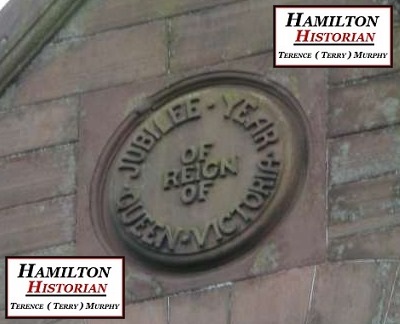 Stone carving (wall plaque) detail for Jubilee Year.
Stone carving (wall plaque) detail for Jubilee Year. E H. Bostock.
E H. Bostock.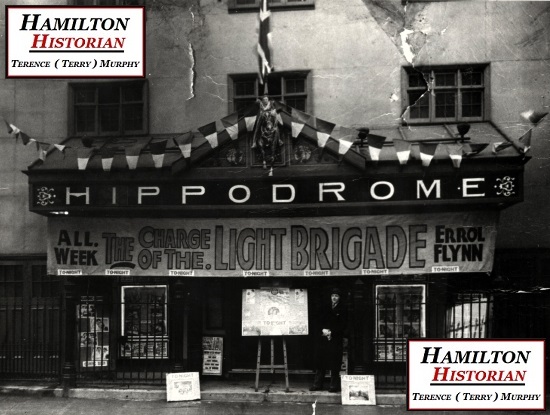 Hamilton’s Hippodrome which used to be located at Townhead Street.
Hamilton’s Hippodrome which used to be located at Townhead Street.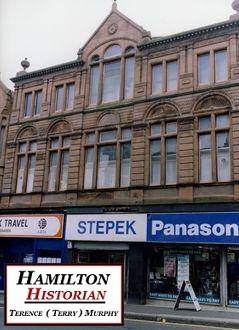 When Stepek owned the building.
When Stepek owned the building.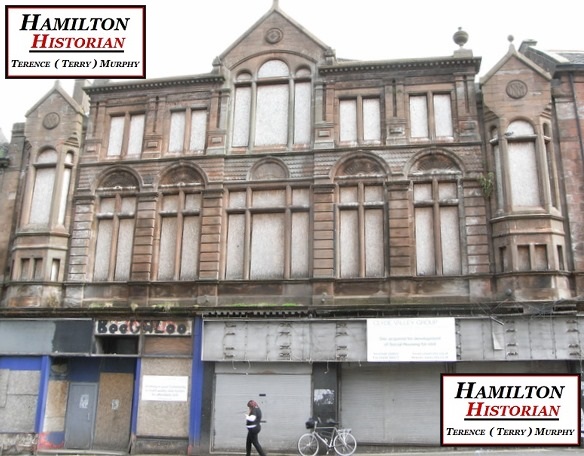 When the building fell into disrepair.
When the building fell into disrepair.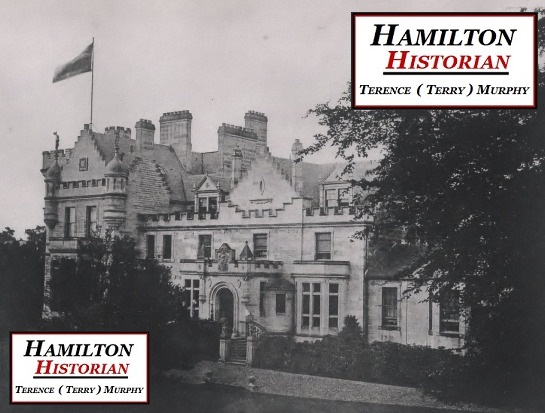 Earnock House c.1889.
Earnock House c.1889.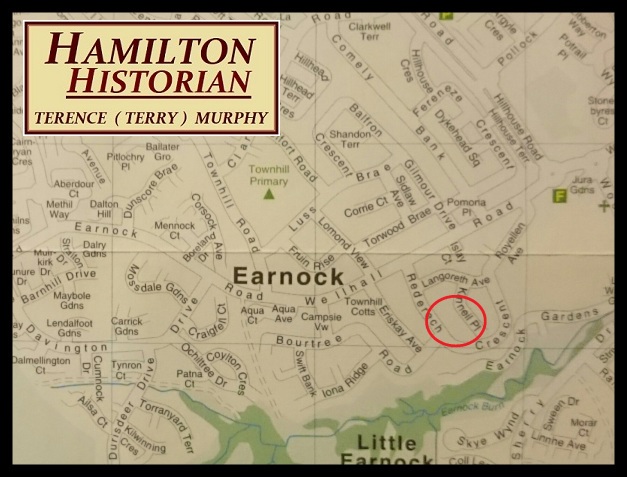 The area circled red in the above map clipping indicates the approximate location of the former Earnock House. Which is now the top end of Rederech Crescent in the Earnock Housing Estate, Hamilton , South Lanarkshire.
The area circled red in the above map clipping indicates the approximate location of the former Earnock House. Which is now the top end of Rederech Crescent in the Earnock Housing Estate, Hamilton , South Lanarkshire.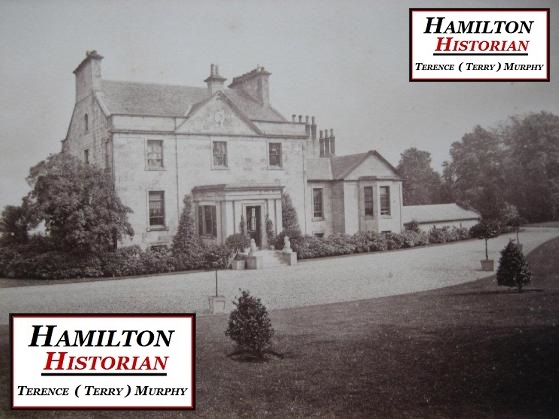 Earnock House before extentions/additions were built c.1877.
Earnock House before extentions/additions were built c.1877.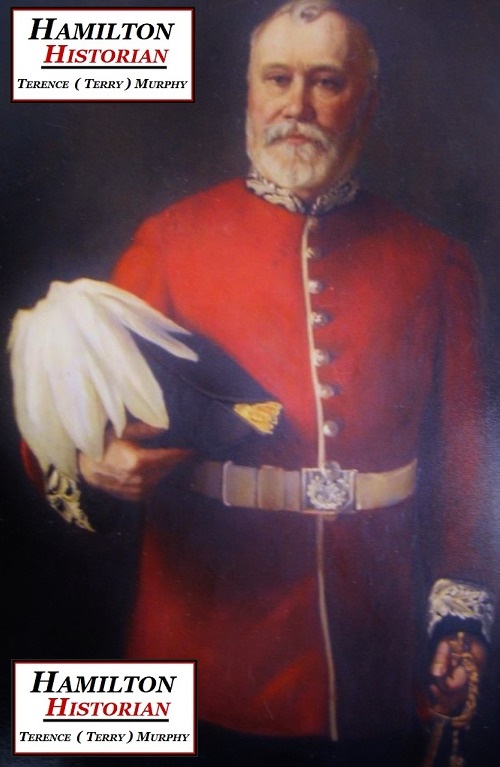
 The “Margaret” Tower addition completed c.1881, this photo c.1889.
The “Margaret” Tower addition completed c.1881, this photo c.1889.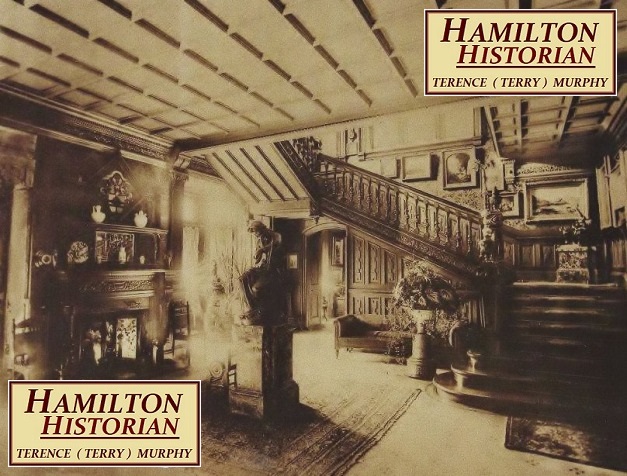 Earnock House Entrance/Hallway c.1889.
Earnock House Entrance/Hallway c.1889.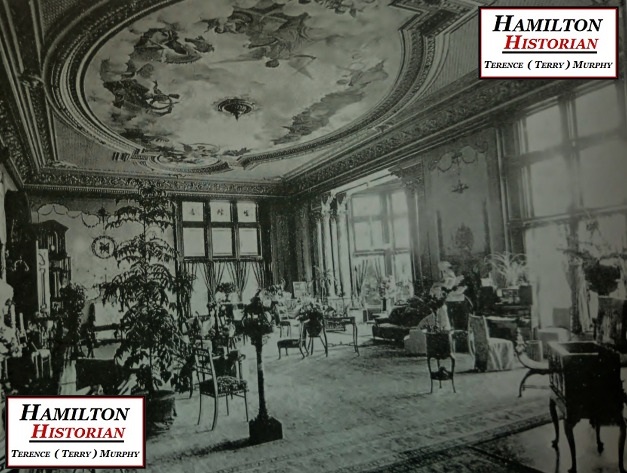 Earnock House Drawing Room c.1889.
Earnock House Drawing Room c.1889.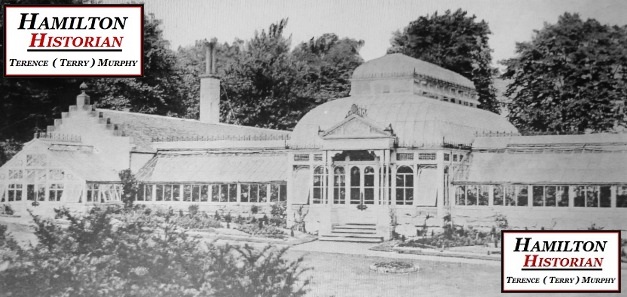 Glasshouse at Earnock Built c.1881 This photo c.1888.
Glasshouse at Earnock Built c.1881 This photo c.1888. This photo of the stables c.1889.
This photo of the stables c.1889.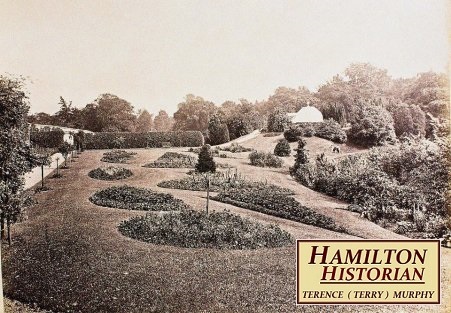 This photo of Earnock Gardens c.1877. The grounds of the Earnock Estate also had a tennis court, bowling green and a golf course which was developed at a later date.
This photo of Earnock Gardens c.1877. The grounds of the Earnock Estate also had a tennis court, bowling green and a golf course which was developed at a later date.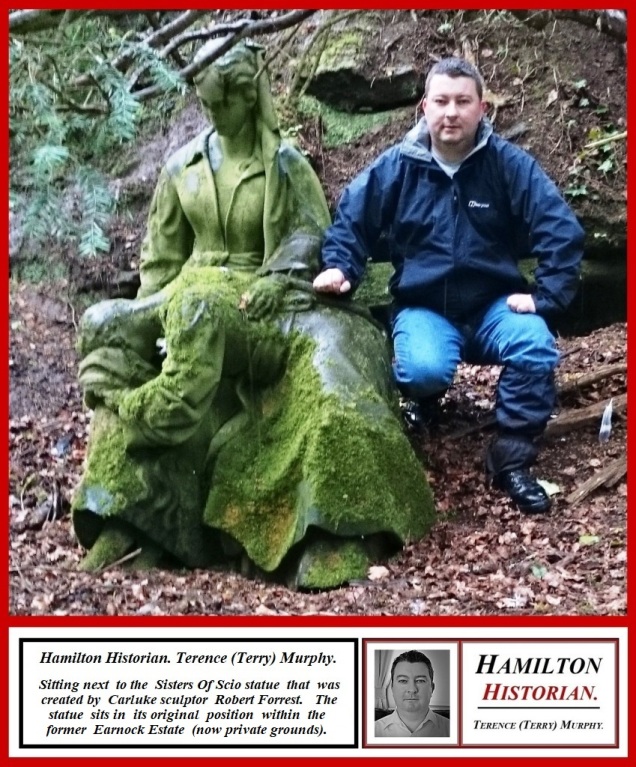 Hamilton Historian. Terence (Terry) Murphy. Sitting next to the Sisters of Scio statue c.2015.
Hamilton Historian. Terence (Terry) Murphy. Sitting next to the Sisters of Scio statue c.2015.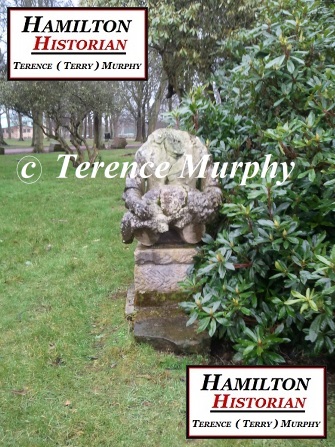 The Gentle Shepherd.
The Gentle Shepherd.
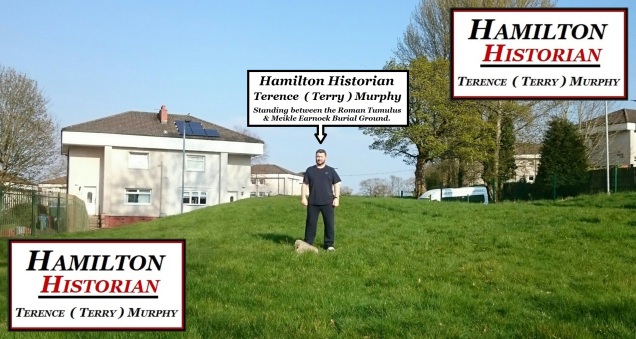

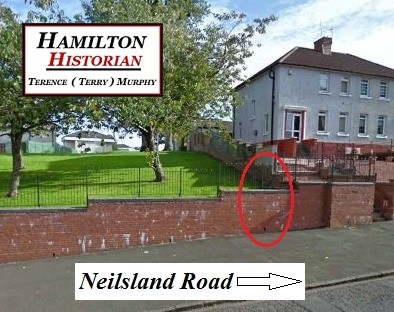
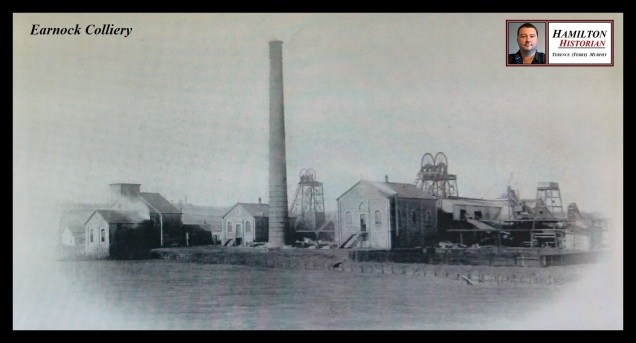 Earnock Colliery.
Earnock Colliery.